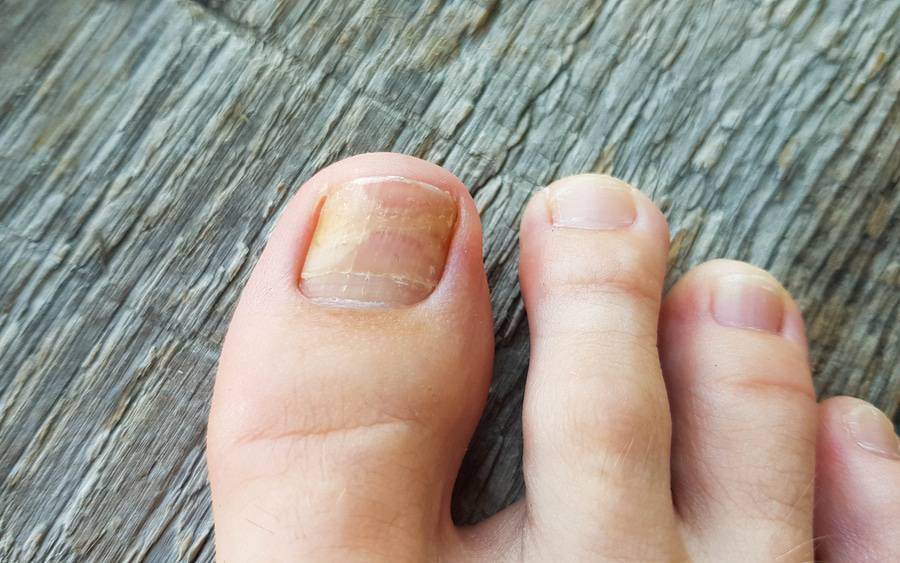Which Toenail Fungus Treatment Is Best?
Treatments include oral and topical meds, natural remedies

Treatments include oral and topical meds, natural remedies
Other than keeping your toenails trimmed and perhaps painted, you may not pay much attention to them — unless a problem develops. Healthy toenails are pink, shiny and smooth, but a fungal infection can cause them to become discolored, thick, brittle and even painful.
Toenail fungal infection, known as onychomycosis, is a common but challenging condition. Toenail fungus treatments include a wide range of options with varying success rates.
Causes of toenail fungus
Fungal nail infections are usually caused by fungi called dermatophytes that infect the skin beneath the nail; yeast is another common culprit. Toenails are especially vulnerable to infection when your bare feet contact damp surfaces, such as showers, swimming pools and locker rooms. If you have athlete’s foot, the infection can spread to the nails.
Wearing closed shoes, such as athletic shoes, for extended periods also can contribute to infection if your shoes and/or socks are damp from perspiration or heat. Moreover, if your shoes fit snugly enough to put pressure on your toes, they can damage the nail bed, making it more susceptible to infection.
People with chronic diseases, such as diabetes or circulatory problems, also may be more prone to toenail infections.
Symptoms of toenail fungus
Toenail fungus symptoms can develop slowly over time and may go unnoticed at first. Symptoms can include:
- Yellowish discoloration at the top of the nail
- Darkening or clouding of nails
- White spots on nails
- Nail thickening
- Distorted nail shape
- Brittle or crumbling nails
- A lack of shine
- Pain in the tips of toes
- Foul odor
- Nail separates from the nail bed
“If your symptoms are severe or cause pain, or your toenail turns brown or black, it’s best to make an appointment with your primary care doctor or podiatrist instead of trying to treat it yourself,” says Stacie Ly, MD, an internal medicine physician at Scripps Coastal Medical Center Carlsbad.
Treatments for toenail fungus
Home remedies
Toenail fungus infections often require diligent treatment to be successful. Early-stage toenail fungus may respond to home treatments, such as those listed below.
- Tea tree oil or eucalyptus oil: Both oils have antifungal properties, and studies found they performed as well as some over-the-counter and prescription topical antifungal treatments.
- Ozonized sunflower oil: A Brazilian study found that sunflower oil worked to treat toenail fungus infection caused by yeast.
- Baking soda: Researchers found that baking soda prevented fungal growth in 79 percent of the specimens tested. Apply a paste of baking soda and water directly to the affected nail and let it sit for at least 10 minutes before rinsing.
- Vicks VapoRub: A very small study found that this mentholated ointment had a positive effect on toenail fungus.
- Vinegar and hydrogen peroxide: These are also popular home remedies for toenail fungus but have not been shown to be effective in clinical studies.
Apply the treatment to the affected nail several times daily; you may need to treat for six months or more to clear the infection.
Over-the-counter medications
Over-the-counter treatments for toenail fungus include creams, ointments, sprays and liquids. Ask your pharmacist for a recommendation or look for these ingredients, and follow the directions carefully:
- Tolnaftate (brand name Tinactin)
- Clotrimazole (Lotrimin)
- Terbinafine (Lamisil)
When to see a doctor for toenail fungus
If your symptoms do not get better with home treatment, make an appointment with your primary care physician or a podiatrist. They may recommend a prescription-strength topical medication, or an oral anti-fungal pill that you take for two or three months. Oral treatment is usually more effective but may interact with other medications. Also, oral treatment can affect the liver, so you may need to have liver function tests while taking the medication.
Toenail fungus laser treatment can temporarily improve the nail but has a lower cure rate than oral medication.
In severe cases that do not respond to treatment, the infected nail may be surgically removed in order to treat the nail bed; a healthy nail can then grow back. A chronically infected and painful nail may be permanently removed.
Unfortunately, toenail fungus can be stubborn — the recurrence rate can be as high as 40 percent.
“If your toenail fungus keeps coming back despite taking preventive measures, see your primary care doctor or podiatrist,” says Dr. Ly. “Something else may be causing it, or you may need a different approach. Your doctor can get to the root of the problem and determine the best course of action.”
Preventing toenail fungus
Follow these guidelines to help keep your toenails healthy:
- Wash your feet with soap and water and dry them thoroughly after swimming.
- Wear shower shoes in locker rooms and public areas.
- Wear shoes that fit well and are made of breathable materials.
- Remove wet or damp socks or shoes as soon as possible and dry your feet.
- Disinfect nail clippers and home pedicure tools.
- If you get pedicures, ensure that your salon follows proper disinfection procedures, and wash and dry your feet when you return home.
- Avoid applying polish to infected nails.
- If you have athlete’s foot, treat the infection.